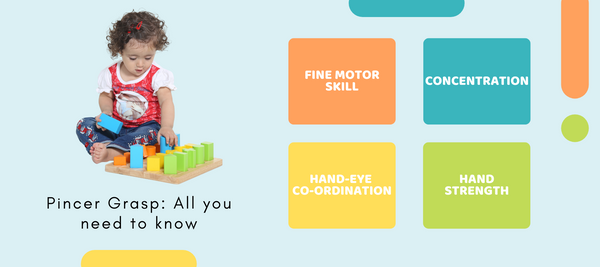Pincer Grasp: All you need to know
Posted on January 30 2023

A Crucial Phase in Baby's Development
Your little one is mastering big milestones as they have just started crawling and maybe even trying to stand holding any possible surface, and honestly those are the big moments that make you as a parent stand back and reminisce at just how fast they are growing up. But just around 9 months to 12 months, there's another key milestone that your baby is trying to develop with their fingers and palm - The Pincer Grasp.
What is the Pincer Grasp?
To put it simply, the pincer grasp is the coordination between the index finger and thumb to hold an object. While for an adult it may seem like a reflex action, for a baby this is an important milestone for fine motor skill development. The pincer grasp is a representation of the coordination between the brain cells and muscles that is crucial for your little one. While it seems like a small action, within a few months, your little one will be using this pincer grasp to try and feed themselves finger food. Mastering the pincer grasp is a key developmental skill because it will soon aid your toddler to learn to button and zip their clothes and eventually, hold a crayon and pencil.
At what age do babies develop the Pincer Grasp?
Anywhere between 8 to 12 months of age is when your little one will start using the pincer grasp. Since it's a skill they have just developed, they will practice using their fingers to pick up everything around them and off the floor. If not careful, they might just put everything that they can grasp directly in their mouth. This is a skill toddlers work on and perfect during their growing months, their grip gets firmer and fewer objects fall through as they grow older. While 8 to 12 months is an estimated timeline to develop this skill, all babies are different and cross different milestones as per their growth. They may be busy acquiring other skills, like waving goodbye or trying to stand on their two feet.
Stages of pincer grasp development
Pincer grasp usually develops as a result of building on several holding and coordination milestones that your little one crosses. Below are some milestones that your little one is likely to develop before they master the pincer grasp:
● Palmar Grasp: The action of bringing the fingers in toward the palm, allowing babies to curl their fingers around an object.
● Raking Grasp: This is when they use their fingers other than the thumb like a rake, curling the top of the fingers over the object to bring items toward them.
● Inferior Pincer Grasp: This is precursor to the pincer grasp and usually develops between 7 and 8 months of age when your little one will start using the pads of the thumb and index finger to pick up and hold objects.
● Superior Pincer Grasp: This is when a child uses the tips of their fingers to pick up objects.
What Toys Can Help with Pincer Grasp?
While babies usually cross milestones themselves; there are several ways you can encourage your baby to develop their pincer grasp. Engaging them with certain toys has proven to be quite effective in honing their fine motor skills. Below are a few recommendations that can help develop your little one’s pincer grasp -
- Multi-Shape Sorting Board

Bright and colourful, this Multi-Shape Sorting Board from Brainsmith helps your baby identify and differentiate between shapes, colours and sizes and develops memory while working on their fine motor skills to further develop their Pincer Grasp.
- Building Blocks in Bear Walker

Building Blocks in Bear Walker is a bear shaped walker full of wooden building blocks for your little one to play, learn, build and stack. With 24 wooden blocks of different shapes and colours to learn from, little children can enjoy building towers and forts of their own imagination or stack them up to make a high tower. This play set builds fine motor skills, creativity, and hand-eye coordination along with cognitive skills.
- 3D Shape Builder

Introduce your little one to the world of 3D with the 3D Shape Builder. They start by matching colours to stack and build 3D shapes on the board. Up your child's creativity and help develop their fine motor skills by playing with colours, shapes, and sizes to create multiple patterns.
Self-Feeding to Develop Pincer Grasp
Encouraging your little one to eat by themselves isn’t just great to make mealtime enjoyable but is a great way to help your little one develop their pincer grasp. You can do this by placing finger food in a suction bowl or a mini mat that stays put on your little one’s high chair so your baby starts using the index finger and thumb to pick the pieces up. Avoid keeping hard food that is difficult to chew and can pose a choking hazard.
It is very crucial for parents to take necessary steps to hone your child’s pincer grasp. The sooner you do it, the better it is for your little one to achieve this important milestone. Aiding your child in strengthening their pincer grasp is what will help your baby develop independent skills such as eating, buttoning, zipping, colouring and writing in the future.
